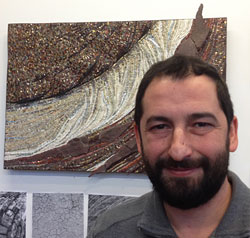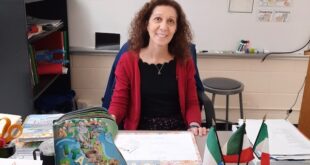
“It’s about 25 centuries old as a medium and if we want to be correct, we should give credit to the Greeks for the invention,” says Matteo Randi, educational director at Chicago Mosaic. “But the Romans who traveled and explored in Greece learned this craft and brought it back to Rome.”
When they did, Ravenna became one of the most important centers for mosaic art in the Roman world, as it was capital of the Western Roman Empire from 402 until 476 A.D. Randi happens to hail from Ravenna, and has practiced in mosaics since age 9. He still uses hammers with crescent-shaped heads–given to him as a youth–that look almost identical to the ones the Romans wielded.
His lifelong love for mosaics brought him to a place that’s the only non-profit mosaic school in the U.S. Karen Ami founded it 10 years ago in a garage, and it has blossomed into a spacious spread that’s part gallery, part workshop, and all heart. It’s home to 12 teachers leading 17 to 20 classes, and acts as a magnet for visiting artists from all over the world.
Along the walls you’ll find reproductions of Byzantine church mosaics found in Ravenna–one way that students at the school grasp the basics. “There’s a lot to making the reproduction; to learn the roots and the grammar, if we consider mosaic a language,” Randi says. “It’s in constant evolution and always changing. Its amazing how you can do this poetry using the same words.”
Speaking of visual poetry, some of Randi’s teachers are represented with masterful works on display. You can see “Cantante Di Blues” by Verdiano Marzi, who teaches at the Louvre in Paris. Paolo Racagni’s “Situazione” is on site as well. Both pieces were finished in 2014.
And while Randi has a modest bearing, the art in his Chicago Mosaic studio reflects a compelling mix of flow and force. “Riposo” (from 2013) features a long slice of cocoa-colored sandstone he fetched from a riverbed while driving to Chicago from New York. To mine it, he turned off his route home after he saw the same color stone beckoning from a nearby peak. “In the river, it’s always what you find on the side of the mountain, and for a mosaic artist the riverbed is like a quarry,” he says.
Yet like the other teachers there, Randi isn’t content to keep the secrets of mosaic making to himself. This man–who can split a large stone in several chops to a neat square the size of nail head–has a small disciple in his daughter. At age 4, she produced a playful square mosaic on display, flecked with joyful bursts of white, orange, blue and green.
It has a fitting theme, even as mosaic traditions take flight in a new generation. Says Randi: “She told me the story of cocoon and a butterfly.”
For the 6th consecutive year, CMS will welcome back mosaic Maestro Verdiano Marzi for two exclusive workshops in March 2015.
A highly regard artist, Marzi is one of the world’s most sought-after teachers of contemporary mosaic.
Two four-day workshops from March 12 to 15 and from March 19 to 22 include complete access to the CMS studio, use of tools and a comprehensive selection of materials.
Each workshop is $850; class size is limited to 12 students.
The Chicago Mosaic School is located at 1806 W. Cuyler Ave., Chicago. For details, call 773-975-8966, email info@chicagomosaicschool.com or visit chicagomosaicschool.com.
 Fra Noi Embrace Your Inner Italian
Fra Noi Embrace Your Inner Italian







The new site looks FANTASTICO! Great work, Paul!
Thanks, Davide!